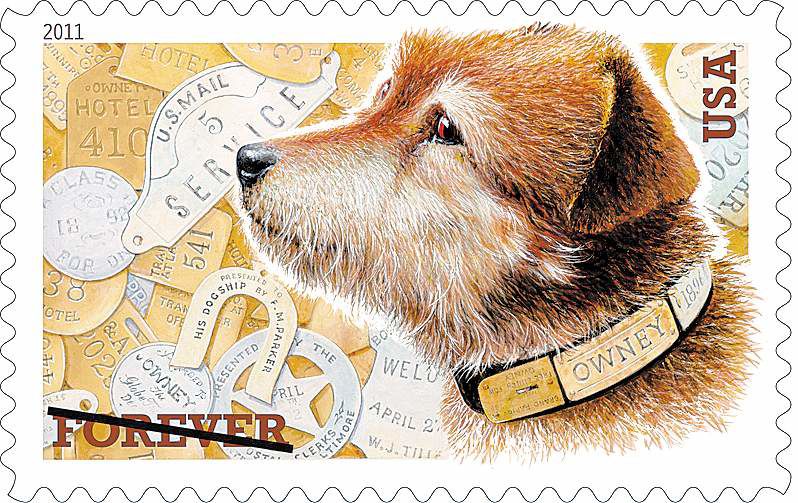1880s mail service mascot gets a makeover, and a stamp
Published 5:00 am Tuesday, August 16, 2011

- With this stamp, the U.S. Postal Service commemorates Owney, the canine mascot of the Railway Mail Service.
WASHINGTON — Owney may be a dog, and just a terrier mix at that. But he’s got a legacy to maintain.
So his owners got him some fur plugs, a new nose, an eye job, a mani-pedi. Owney, after all, has been dead for 114 years and, frankly, was starting to show his age.
Owney, whose home is the Smithsonian Institution, is a bit of a national icon — with a starring role in the history of the U.S. mail service. In 1888, the mutt wandered into the Albany, N.Y., post office, spent the night on a pile of mailbags and became an instant favorite among the clerks. He started riding along with the mailbags on the Railway Post Office, traveling across the United States on the trains and guarding the mail.
Owney’s travels were cut short July 11, 1897. While visiting Toledo, Ohio, he became aggressive and allegedly attacked a mail clerk. The postmaster called the town marshal, who shot the dog.
But rather than bury their much-loved mascot, the mail clerks pulled together the money to have him preserved by a taxidermist. He was displayed at the Post Office Department’s headquarters in Washington until 1911, when he was transferred to the Smithsonian.
“When my son first saw Owney when he was a kid, he had nightmares afterward,” said Linda Edquist, a conservator at the National Postal Museum and the force behind Owney’s restoration. “The first thing you saw was his belly with this big suture mark running up it, so no wonder.”
That was the day Edquist vowed she would get Owney fixed up, eventually.
That chance came along this year when the museum learned that Owney’s likeness would grace a new Forever stamp scheduled for release Wednesday.
“We saw it as the perfect opportunity to carry out the restoration that we had been talking about doing all along,” she said.
So the museum began raising money, and a $10,300 Smithsonian preservation fund grant was set aside to clean, conserve and digitally photograph Owney.
The Smithsonian collection also includes more than 470 medals and trinkets Owney has received from admirers who wanted to commemorate his visits to their towns. Those items will be restored, and the exhibit will be redesigned.
In May, the dog was removed from the exhibit and replaced with a “phony Owney” placeholder during the restoration. Last month, he was taken for his 2½-week “spa” retreat at the Point of Rocks, Md., studio of retired Smithsonian taxidermist Paul Rhymer.
There’s no doubt that Owney came back a changed dog.
“My restoration got it back about halfway to what it should have looked like,” said Rhymer, who said the original taxidermy work left Owney’s skin fragile and his nose shriveled. “We decided to try to make him look a little better, a little more realistic.”
Owney’s facial reconstruction included hand-sculpting a new snout using a cast coyote nose for structure and giving him a new set of eyes. Using historical photos for reference, Rhymer also replaced some of his nails, removed the wax and paint that was weighing down his fur and patched up some bald spots with a carefully matched coyote pelt. He also made the suture lines from the original taxidermy work less nightmare-inducing.
But through all that, Rhymer said his goal was to stay true to the dog and his iconic part in the history of the U.S. mail service.
“It’s not like I can turn him into an Irish setter,” he said. “He still has to look like the real thing.”
Owney returned to the museum in early July to be prepped for display and decked out in his restored medals. Just in time, too.
The museum is hosting a four-day family festival, beginning Wednesday and continuing with museum activities through Saturday in his honor, coinciding with the release of the Forever stamp. Also coming out are new interactive maps and digital catalogs of his tags and trinkets, a song and an e-book.
They’ve even created an augmented reality program so that when the Forever stamp is held up to a computer Webcam, Owney comes to life, barking and trotting along with his tags jingling.
“This dog, he’s that indefatigable character that can throw you back into history,” said Edquist. “It’s a great way to connect people to the 1890s.”
More on Owney
For more on Owney’s restoration, visit the National Postal Museum’s website, www.postalmuseum.si.edu.






